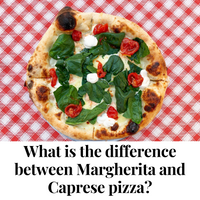While there are many similarities between regular pizza and gluten-free pizza, there are also some differences. When starting a gluten diet, you may seldom wonder about the main differences so that you can hop on your gluten-free pizza journey!
The main difference is in the dough. Regular pizza dough is made from wheat flour, and gluten-free dough is made from non-gluten flour. Gluten-free dough is usually made with higher starch content and needs to be stretched out more. When stretching it, you should use a silk pat or parchment paper to prevent the dough from shrinking.
In this article, we’ll discuss all you need to know about the differences between regular and gluten-free pizza. We’ll also tell you if it’s worth it or not. Without any fighter ado, let’s begin!
Best Gluten-Free Pizza From Italy to the USA
When choosing a gluten-free pizza, look for ingredients that are low in calories. Many popular pizza chains offer gluten-free pizza that is about 300 calories per slice. You can also try to reduce the amount of cheese by half.
This will help reduce the number of calories, sodium, and saturated fats. Instead of whole-fat cheese, look for part-skim cheese. A gluten-free pizza loaded with meat, like those sold at Domino's, will still contain many calories.
Thus, the best gluten-free pizza that’s also good for maintaining your cholesterol levels can be found in authentic Margherita pizza from Italy. It will undoubtedly keep you healthy while ensuring you get the best taste of Italy.
The Main Differences Between Gluten-Free Vs. Regular Pizza
One of the biggest differences between regular and gluten-free pizza is the amount of fat. Many gluten-free pizzas contain cheese substitutes, which can be higher in fat and calories. So, choosing a low-fat pizza is important to lose weight or stay healthy.
So, let’s note some of the healthy differences below!
Crust
Another major difference between regular pizza and gluten-free pizza is the crust. Gluten-free pizza crusts are usually a little thinner than regular pizza crusts.
They may also be made with different flour than regular pizza crusts. This may give them a different taste, but most people report that gluten-free pizzas are similar to their regular counterparts.
To avoid cross-contamination, pizza bakers should use dedicated tools and clean countertops. You should wash your hands and change gloves before preparing a gluten-free pizza, as it needs to be completely dry and hygienic.
Carbs
Gluten-free pizza crusts are generally low in carbohydrates. However, be careful when selecting a gluten-free pizza - some brands use alternative flours for the crust, which are higher in carbs than wheat flour.
Also, gluten-free pizzas may contain cheese or meat in addition to flour, which can increase the carb count.
A gluten-free pizza can still contain high fat, calories, and sodium. As long as you know the ingredients and portion size, gluten-free pizza can still be a healthy choice. Just remember that it is better to eat a small slice of gluten-free pizza rather than a whole pie.
Reducing gluten in your diet is healthy and can help you live a better, more active life. It can also reduce your risk of chronic illnesses and lower cholesterol levels. Gluten-free foods also improve your digestion, making you feel better and have more energy.
What Is The Difference Between Regular Crust and Gluten-Free Crust
When it comes to pizza crusts, there are two main types. One is made from wheat starch, a common ingredient in Europe but little known in the United States until recently.
It is a fine white powder obtained by washing the gluten-forming proteins out of wheat berries. While it doesn't give the dough much elasticity, it does add texture and a wheat-like taste.
If you are concerned about the health impact of gluten, you can order a gluten-free pizza from places like Domino's. Domino's Gluten-Free Crust is made from rice flour, rice starch, and potato starch, with a gluten content of less than 20ppm. Using this crust allows you to order any topping you like.
If you're worried about the calorie content of gluten-free pizza, it's wise to check the label carefully before making the purchase. Even if labeled gluten-free, a slice of pizza can contain more than 300 calories. Limit yourself to one or two slices to control your calorie intake. Alternatively, you can choose to add some vegetables to your gluten-free pizza to get some extra fiber and nutrients. This will help you enjoy pizza guilt-free.
In recent years, gluten-free pizza has become a popular menu item. Unlike the traditional wheat crust, the gluten-free crust is made of alternative flour, such as rice flour, tapioca starch, and cornmeal. These flours often have higher calorie content, and gluten-free crusts can contain more fat and salt than their wheat-based counterparts.
Best Flour For Gluten-Free Pizza
When choosing the right flour to use, read the label closely. Gluten-free flour contains different ingredients than regular flour, and each ingredient plays a role in creating the desired flavor and texture. In addition, gluten helps dough rise so that gluten substitutes can replicate the texture of traditional dough.
Another difference between regular and gluten-free crusts is the amount of fiber and protein per serving. Cauliflower crusts contain less fiber and protein and are low in protein and fat.
Gluten-free crusts contain more fiber and protein and 430 grams of sodium per serving. However, they're still not recommended for people with celiac disease or gluten sensitivities.
Pizza crusts made from gluten-free flour are also dairy-free and nut-free. Pizza crusts made from these flours are a crowd-pleaser and are great for adding your favorite toppings. Gluten-free pizza crusts are also a good option if you're looking to avoid gluten and wheat.
Is Gluten-Free Crust Pizza Better Than Regular Pizza
While you may not want to give up pizza entirely, a gluten-free crust pizza can be a healthier choice for your family.

Unlike traditional pizza, which contains gluten, the gluten-free crust contains no wheat or other grains. There are several different recipes available for gluten-free crusts.
Some people find that gluten-free pizza has a lower carb content than traditional crust pizza. However, that is not always the case.
Some types of gluten-free pizza contain more sugar and carbs than their regular counterparts. Often, you may find that it is not as satisfying as traditional pizza.
Another thing to consider is the number of calories. Although a gluten-free pizza is healthier, it may still be high in sodium and saturated fat. You'll want to watch the number of toppings and the amount of pizza you eat.
You may want to stick to a thin-crust version. A full-size pizza can have as many calories as two slices of traditional pizza.
Best Toppings For Gluten-Free Pizza
Adding meat toppings to your pizza may increase its calories and saturated fat content. Sausages and pepperoni can add a significant amount of calories.
Adding more vegetables to your pizza may help reduce the calories you consume. Moreover, veggies are rich in fiber and antioxidants.
While gluten-free crust pizzas can be as delicious as regular pizza, they are not the same. The main difference is that they are made with different ingredients. Gluten-free crusts are often made with rice flour, almond flour, or potato starch.
Different texture. It will still be chewy but will not contain the gluten that regular crust pizza does.
Making Your Crust
Depending on your diet, you can choose a gluten-free crust. However, it is important to check the nutritional facts before deciding. Most pizzas with gluten-free crusts contain around 30 grams of carbohydrates per serving, which may violate your daily carbohydrate goal.
If you're concerned about calories, you can try making your crust. You can use rice flour, brown rice flour, or tapioca starch. Homemade crusts don't need to rise. But they will rise during the baking process, resulting in a fluffier crust.
Final Words
Therefore, we hope you know everything about the differences between regular and gluten-free pizza. While regular crust pizzas are not too bad, having gluten-free pizza will give you a healthy boost.
And if you’re wondering where you can get the best gluten-free pizza around you, Pizza Bien's gluten-free pizza has you covered. Till the next time, happy feasting!
Our real Italian pizzas from Italy are handmade with all-natural high quality and fresh ingredients in Naples, Italy delivered to you, anywhere in the U.S. Click Here to Buy Now!
Disclaimer: The content on this blog post and website is not intended to be a substitute for professional medical advice, diagnosis or treatment. Always consult with a qualified and licensed physician or other medical care provider, and follow their advice without delay regardless of anything read on this website.
Always follow your doctor's advice and health care instructions!









0 comments